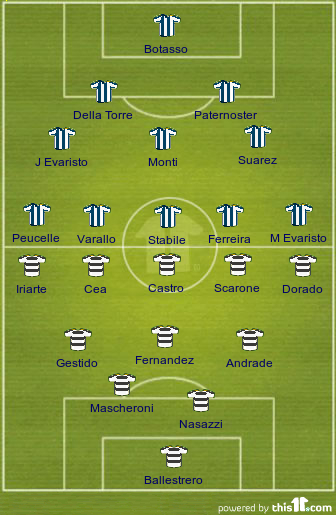The Pyramid
The next great change in football tactics was a move to the formation which would endure for over 50 years, and in some nations much longer. While the Scottish formation provided greater balance than the chaos which went before, it still saw the attack overloaded and resulted in each attacker having little space to play in.
In the 1878 Welsh Cup final Wrexham faced Druids and for them EA Cross (previously a centre-forward) was deployed as a centre-half. By withdrawing one of the forwards into the half-back line, a team could bolster its defensive strength and provided a better balance to the team. Wrexham were vindicated for their innovation, as they defeated Druids 1-0 to claim the cup and before long other teams were following them.
The newly created centre-half soon became the most important player in the team. Acting as the focal point of the side, the centre-half was expected to link the defence with attack and was consequently involved in the game probably more than any other player.
The addition of the centre-half also radically changed the roles of the other players behind the forward line. As the centre-half slotted in, the right and left-halves (wing-halves) were pushed wider from a previously central role. When out of possession the wing-halves were expected to defend against the opposing wingers, as modern defenders would do. With the wingers covered by the wing-halves, the full-backs were now only expected to defend against the two inside-forwards and the remaining centre-forward.
As passing increasingly came to be accepted there was a gradual change in the role of the forwards. The outside-forwards became more and more providers for the centre-forward, who in British football would be expected to challenge keepers for headers and, if necessary, charge them into the goal. Wingers such as Billy Meredith of Wales
Inside forwards also became more creative as well, and were less and less relied on for goals. Great dribblers such as Nuts Cobbald remained admired, but the new style of inside-forward was more like that famous passer GO Smith than his predecessor.
What the game also began to see more and more was movement to aid the passing. Even under the classical Scottish passing style most players were static when the gave and received the ball. In the early 20th century that style was built on as teams played in triangles, constantly moving into a better position to receive the ball and then play it on. The first team to do it well were Sunderland whose “infernal triangle” would see the trio of Buchan, Mordue and Cuggy gradually progressing further up the pitch by passing the ball between them. Spurs in turn improved on the system, but it was overseas that it was taken to the highest level.
 |
| Uruguay (below) v Argentina, 1930 |
The Uruguay
Such was the success of the pyramid that it remained in place the world over until the 1930s. In nations such as Austria and Uruguay it remained the system of choice into the 1950s and it was only in the 1960s that printed formations were no longer often shown in that style.

No comments:
Post a Comment